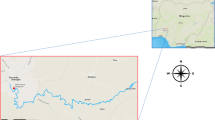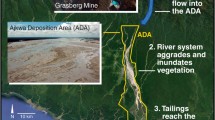Abstract
On the Kola Peninsula, the mining and concentration industry exerts anthropogenic impact on the environment. Tailing dumps cause airborne pollution through dusting, and waterborne pollution due to direct dumping and accidental releases. The objectives were: (1) to analyse multidate satellite imagesfor 1964–1996 to assess the environmental pollution from themining and concentration activity in the Kola in temporal perspective; (2) to evaluate remote sensing methods for integrated environmental impact assessment.
• The area of mining and industrial sites steadily expands and amounted to 94 km2 in 1996.
• The polluted water surface amounted to at least 150 km2 through dumping in 1978 and to 106 km2 in1986 due to dusting. Thus, the impact from the mining and concentration activity should be reconsidered as more significant than it was officially anticipated.
• In the past the main mechanism of pollution wasdirect dumping into the lakes. Currently and in future, airborne pollution after dusting storms will dominate. The effective recultivation of the tailing dumps will be a long-term process.
• For effective assessment of impacts from the mining and concentration industry, remote sensing methods should be complemented by in-situ measurements, fieldwork, and mathematical modelling.
Similar content being viewed by others
References
Allum, J. A. E. and Dreisinger, B. R.: 1986, ‘Remote sensing of vegetation change near Inco's Sudbary mining complexes’Int. J. Remote Sensing 8(3), 399–416.
Anonymous: 1999, ‘The state of the environment and environmental problems on the Kola Peninsula in 1998’Murmansk: Report of the State Committee on the Environment of the Murmansk Oblast.
Artobolevski, V. I., Makarova, T. D., Moiseenko, T. I. and Ratkin, N. E.: 1989, ‘Ecological Problems and Variants of Solving’in Planning of Intensification of Industry and its Main Directions in the Murmansk Area, Apatity: Kola Science Centre, pp. 95–101 (in Russian).
Author group: 1999, Ecological Atlas of the Murmansk Oblast, Moscow: Moscow State University, Apatity: Kola Science Centre. (in Russian).
Baklanov, A. and Rigina, O.: 1998, ‘Environmental Modelling ofMining and Concentration Activity in the Kola Peninsula, North-West Russia’in Proceedings of the XI World Clear Air and Environment Congress, 14–18 September 1998, Durban, South Africa, IUAPPA-NACA, Vol. 1, 4F-3, 8 pp.
Barabanov, A. V., Kalinina, T. A., Kiselev, A. A. and Krasnobaev, A. I.: 1999, Giant in Hibinys, Moscow: Ruda i Metally, 288 pp. (in Russian).
Böhm, C., Kühnen, A. and Reimer, W.: 1998, ‘Monitoring the Environmental Hazards and Rehabilitation Activities of Former GDR Uranium and Lignite Mining Areas’in Proceedings: The 27th International Symposium on Remote Sensing of Environment’8–12 June 1998, Tromsø, Norway, pp. 754–757.
Chidzikov, V. V.: 1980, ‘Hydro-Chemistry and Bottom Sediments of the Imandra Lake under Impact of Industrial Pollution’in The Ecosystem of the Imandra Lake under Impact of Industrial Pollution, Apatity: Kola Science Centre, pp. 24–64 (in Russian).
Chudnenko, K. B., Karpov, I. K., Mazuhina, S. I., Bychinsky, V. A. and Artimenko, M. A.: 1999, ‘Dynamics of megasystems in geo-chemistry: Creation of the base models and algoritms of imitation’Geol. Geophys. 40(1), 45–61.
Dauvalter, V.: 2000, ‘Appropriateness of Sedimentation in Water Objects of European Subarctic (Nature Protection Aspects of Problem)’Dr. Sci. Thesis, Apatity: Kola Science Centre, 399 pp. (in Russian).
Desiato, F. and Giminelli, M. G.: 1991, ‘Plume dispersion investigated by Landsat imagery’Atmos. Environ. 25A(5/6), 965–978.
Ekstrand, S.: 1993, ‘Assessment of Forest Damage Using Landsat-TM, Elevation Models and Digital Forest Maps’Ph.D. dissertation, Stockholm: Royal Institute of Technology.
Ferreira, F., Scheepers, F. and Sevenhuysen, P.: 1998, ‘Geo-spatial Techniques to Assist in the Management of Tailings Dams’in Proceedings: The 27th International Symposium on Remote Sensing of Environment’8–12 June 1998, Tromsø, Norway, pp. 762–765.
Hagner, O. and Rigina, O.: 1998, ‘Detection of forest decline in Monchegorsk area’J. Remote Sensing Environ. 62, 11–23.
Kalabin, G. V., Krasnoselsky, E. B., Talalaev, S. M., Baklanov, A. A., Mesyats, S. P. and Rigina, O. Yu.: 1989, ‘Dust Content of Industrial Region Atmosphere at Different Methods of Tailing Dump Surface Consolidation’in M. E. Chalkey et al. (eds), Tailings and Effluent Management: Processing of the Int. Symposium on Tailings and Effluent Management, Halifax, Canada, August 20–24 1989, NY: Pergamon Press, pp. 247–253.
Kalabin, G. V.: 2000, Ecodynamic of Anthropogenic Environment Province of the North, Apatity: Kola Science Centre, 292 pp. (in Russian).
Kryuchkov, V. V.: 1988, ‘Industrial Impact on Nature by Scientific-Technical Revolution’in Antrhropogenic Impact on Ecosystems on the Kola North, Apatity: Kola Science Centre, pp. 4–19 (in Russian).
Kryuchkov, V. V.: 1993, ‘Environmental of the Central Part of the Kola Peninsula: Relief, Climate, Soil, Vegetation, Emission Sources’in M. Kozlov, E. Haukioja and V. Yarmishko (eds), Aerial Pollution in Kola Peninsula, 14–16 April 1992, St.-Petersburg, Russia. Apatity: Kola Science Centre, pp. 12–15.
Lillesand, Th. M. and Kiefer, R. W.: 1994, Remote Sensing and Image Interpretation, New York: John Wiley & Sons, 750 pp.
Mack, C., Marsh, S. E. and Hutchinson, C. F.: 1995, ‘Application of aerial photography and GIS techniques in the development of a historical perspective of environmental hazards at the ruralurban fringe’PE&RS 61(8), 1015–1020.
Mazuhina, S. I. and Moiseenko, T. I.: 2000, ‘Modelling the behaviour of elements of chemical contents of waters under complex pollution (for the Lake Imandra as an example)’Water Resour. 27(5), 538–542 (in Russian).
McDonald, R. A.: 1995, ‘Corona: Success for space reconnaissance, a look into the Cold War, and a revolution for intelligence’PE&RS 51, 689–719.
Mikkola, K.: 1996, ‘A remote sensing analysis of vegetation damage around metal smelters in the Kola Peninsula, Russia’Int. J. Remote Sensing 17(18), 3675–3690.
Moiseenko, T. I., Rodyushkin, I. V., Dauvalter, V. A. and Kudryavtseva, L. P.: 1996, ‘Quality Formation of Surface Waters and Bottom Sediments under Anthropogenic Load on Water Catchments within the Arctic Area’Apatity: Kola Science Centre, 263 pp. (in Russian).
Moiseenko, T. I., Dauvalter, V. A. and Rodyushkin, I. V.: 1997, Geochemical Migration of Elements in Subarctic Freshwater Body (on the Example of the Imandra Lake), Apatity: Kola Science Centre, 127 pp. (in Russian).
Mäkinen, A., 1994: ‘Biomonitoring of Atmospheric Deposition in the Kola Peninsula (Russia) and Finnish Lapland, Based on the Chemical Analysis of Mosses’Report 4, Helsinki: Ministry of the Environment.
Pope, P., Eeckhout, E. V. and Rofer, C.: 1996, ‘Waste site characterization through digital analysis of historical aerial photographs’PE&RS 62(12), 1387–1394.
Prakash, A. and Gupta, R. P., 1998: ‘Land-use mapping and change detection in a coal mining area – a case study in the Jharia coalfield, India’Int. J. Remote Sensing 19(3), 391–410.
Rigina, O. and Kozlov, M. V., 2000: ‘The Impacts of Air Pollution on the Northern Taiga Forests of the Kola Peninsula, Russian Federation’in J. L. Innes and J. Oleksyn (eds), Forest Dynamics in Heavily Polluted Regions, IUFRO Research Series 1, pp. 37–65.
Rigina, O. and Baklanov, A.: 1995, ‘Numerical Modelling of Gas-Dust Plume Dispersion into Atmosphere after Mass Explosions'. in H. Power, N. Moussiopoulos and C. A. Brebbia (eds), Air Pollution III, Vol. 1: Air Pollution: Theory and Simulation, Southampton: CMP, pp. 117–124.
Rigina, O., Baklanov, A., Hagner, O. and Olsson, H.: 1999, ‘Monitoring of forest damage in the Kola peninsula, northern Russia, due to smelting industry’J. Sci. Tot. Environ. 229(3), 147–163.
Rigina, O.: 1991, ‘Numerical Modelling of Gas-Dust Cloud Diffusion into the Atmosphere after Mass Explosions’in Mathematical Modelling of Atmosphere Pollution Processes at Mining Industry Sites, Apatity: Kola Science Centre, pp. 68–74, (in Russian).
Rigina, O.: 1993, ‘Investigation of Atmosphere Pollution from Mining Industry on the Kola Peninsula on the Base of 3-Dimensional Models’in B. Sivertsen (ed.), Proceedings of the Seminar on Air Pollution Problems in the Northern Region of Fennoscandia, Included Kola, 1–3 June 1993, Svanvik, Norway, NILU, pp. 89–103.
Rigina, O.: 2000, ‘Detection of Forest Decline by High-Resolution Satellite Imagery’in T. Knudsen (ed.), Proceedings of the Seminar on Remote Sensing and Image Analysis Techniques for Revision of Topographic Databases, 29 February 2000, Copenhagen, Copenhagen: Kort and Matrikelstyrelsen, pp. 62–65.
Selikhovkin, A.: 1993, ‘Stressing Agents in Forests of the Kola Peninsula’in M. Kozlov, E. Haukioja and V. Yarmishko (eds), Aerial pollution in Kola Peninsula, 14–16 April 1992, St.-Petersburg, Russia. Apatity: Kola Science Centre, pp. 47–52.
Yakovlev, V.: 1995, ‘Assessment of Long-Term Changes in Phytoplankton and Zoobenthos Communities in Large Subarctic Lake Imandra’in T. Moiseenko and V. Yakovlev (eds), Problems of Chemical and Biological Monitoring of the Ecological State of the Kola North Surface Waters, Apatity: Kola Science Centre, pp. 72–104 (in Russian).
Author information
Authors and Affiliations
Rights and permissions
About this article
Cite this article
Rigina, O. Environmental Impact Assessment of the Mining and Concentration Activities in the Kola Peninsula, Russia by Multidate Remote Sensing. Environ Monit Assess 75, 13–33 (2002). https://doi.org/10.1023/A:1014248522919
Issue Date:
DOI: https://doi.org/10.1023/A:1014248522919




